|
||||||||||
Bruce Brown's 100 Voices... John M. Ryan's Story of the Battle
THE NARRATIVE OF JOHN M. RYAN 1ST SGT., "M" CO., 7TH CAVALRY
It appears that General Custer and some of the scouts had gone ahead and got some information of the presence of the Indian camp. After Custer came back the officers were called and he gave directions about the battalion formations. We ate a hearty breakfast first and for our bill of fare had raw bacon, hardtack and cold water, which we relished very much. Here General Custer split the regiment up into three battalions. The battalion that he took immediately under his command consisted of Troop C, commanded by Capt. Thomas W. Custer, the general's brother; Troop I, commanded by Capt. Myles W. Keogh; Troop F, commanded by Capt. George W. Yates; Troop L, commanded by First Lieut. James Calhoun, General Custer's brotherin-law; Troop E, commanded by First Lieut. Algernon E. Smith. He gave another battalion of three troops in command. of Maj. Marcus A. Reno, consisting of Troop M, commanded by Capt. Thos. H. French; Troop G, commanded by First Lieut. Donald McIntosh; Troop A, commanded by Capt. Myles Moylan. The third battalion was commanded by Capt. Frederick W. Benteen, consisting of his own Troop H; Troop K, commanded by First Lieut. Edward S. Godfrey, and Troop D, commanded by Captain Thomas B. Weir. About 150 pack mules constituted the pack train under an escort of Capt. Thomas M. McDougall with his own Troop B; also a detachment from each of the other 11 companies under the command of First Lieut. Edward G. Mathey of Troop M. This pack train followed Custer's trail, and later joined Reno's battalion on the bluffs, which was very fortunate, as we almost ran out of ammunition. Find Indian Lodges We then rode over the divide. Lieutenant Hodgson, who was assigned as adjutant to Reno's battalion, rode from front to rear of the battalion, giving orders to ride a little off from the preceding company, so that we would not raise a large dust cloud, which would warn the Indians of our approach. After crossing the divide, we moved down through a small valley, and around the foot of the bluff. We saw a few abandoned lodges, with the fronts of them tied up, and it appeared that General Crook's command had an engagement on the seventeenth with some of those Indians, and as some of their chiefs were killed, their bodies were put in these lodges, which accounted for the fronts of them being tied up, although we did not know what they contained at the time, and I think Custer had preparations made to charge that camp, thinking it was an Indian camp. When we got as far as that, we could look down this little valley, and see objects ahead of us. We could not tell whether they were Indians or buffaloes. At this point I understand that Custer gave the command to Reno to overtake those Indians, and he would support him, although I did not hear that order given myself. This was the last we saw of Custer's battalion until we found their bodies on the morning of the twenty-seventh. Custer took his battalion and branched off to the right. Reno's battalion followed the valley right down from this point to the Little Big Horn river, and Benteen branched off to the left.
We arrived at the bank of the Little Big Horn river and waded to the other side, and here there was a very strong current, and there was quicksand about three feet deep. On the other side of the river we made a short halt, dismounted, tightened our saddle girths, and then swung into our saddles. After mounting we came up, "Left front into line," Captain French's Company M, on the right and Lieutenant McIntosh's company on the left, and Captain Moylan's in the rear. We were then in the valley of the Little Big Horn, and facing down stream. We started down on a trot and then on a slow gallop. Between the right of my company and the river bank there was quite a lot of underbrush, and bullberry bushes. Captain French gave me orders to take 10 men off to the right of my company and form a skirmish line, so as to cover the brush from the right of our line to the river bank, as the Indians might be lurking there. We advanced in that formation from one and a half to two miles, until we came to a heavy piece of timber. Hears First Shot Before we arrived at the timber, there was one shot fired away ahead of us. I did not know whether it was fired by Lieutenant Varnum's scouts or one of the hostile Indians. That was the first shot that I heard in the opening of the battle of the Little Big Horn on June 25, 1876, and I had pretty good ears about that time. Private James Turley of my troop when we arrived at the timber and had orders to halt, could not control his horse which carried him towards the Indian camp. That was the last I saw of him. He was a very nice young man. A little incident happened a day or two before we left Fort Rice to go on the expedition. Turley asked me if I would allow him to put some of his property in my clothes chest. I told him that I would with the understanding that if he was killed the contents of the chest would belong to me and if I was killed it would belong to him. After coming back from the expedition the property belonging to those men that were killed was sold at public auction and the proceeds turned over to the paymaster. When we got to the timber we rode down an embankment and dismounted. This was where the channel of the river changed and was probably several feet lower than the level of the prairie. We dismounted in haste, number four of each set of four holding the horses. We came up onto higher ground forming a skirmish line from the timber towards the bluffs on the other side of the valley and facing down stream in the direction of the Indian camp. This was our first view of the Indian camp from the skirmish line. Some of the men laid down while others knelt down. At this particular place there was a prairiedog town and we used the mounds for temporary breast works. We got the skirmish line formed and here the Indians made their first charge. There were probably 500 of them coming from the direction of their village. They were well mounted and well armed. They tried to cut through our skirmish line. We fired volleys into them repulsing their charge and emptying a number of their saddles. Lieutenant Hodgson walked up and down the line encouraging the men to keep cool and fire low First Man Killed Finally when they could not cut through us, they strung out in single file, lying on the opposite side of their ponies from us, and then they commenced to circle. They overlapped our skirmish line on the left and were closing in on the rear to complete the circle. We had orders to fall back to our horses. This was where the first man was killed, Sergt. Miles F. O'Hara of my troop M. He was a corporal going out on the expedition and promoted to a sergeant a few days before his death to replace Sergt. John Dolan, who was discharged, as his term of service had expired, and was back with the wagon trains at Powder river. Sergeant O'Hara was considered a very fine soldier in M troop and we missed him very much. In the Indian camp after the battle, when we were destroying it, we found the heads of three of our men tied together with wires and suspended from a lodge pole with their hair all burned off. We did not see their bodies there. The Indians probably threw them into the river. We got back to our horses and the orders were given to mount and this time some of the men became confused and some of them could not find their horses.
Reno Leads Charge The order was then given to charge, and away we went up the steep embankment, cutting through the Indians in a solid body, Major Reno being in advance. As we cut through them the fighting was hand to hand, and it was death to any man who fell from his horse, or was wounded and was not able to keep up with the command. After cutting through we went back over the same ground, and then took a circle to the left to gain the bluffs at the nearest point. Here there was some pretty sharp fighting. The Indians were in great numbers on all sides of us. In this charge there were 30 men killed, my company losing 10, but we reached the river.
Lieutenant DeRudio and Fred Girard [Fred Gerard], a white scout, and some 10 or 12 men became separated from the command and hid themselves in the brush or in the woods, or under the river embankment, and some of those men told me afterwards that they stood in water up to their necks, under the embankment, to keep out of sight of the Indians. Two of those men were sergeants of my company, Charles White and Patrick Carney. They joined the command in the intrenchments on the bluff, after dark. At this point the river was about 50 yards wide, and the water about two and a half feet deep, with a swift current. Lieutenant Hodgson asked one of the men to carry him across, he being wounded and his horse being shot. It was reported that a trumpeter from my company named Fisher, better known as "Bounce," told him to hold on to his stirrup, and the horse drew the lieutenant as well as the rider across the river. He was shot a second time and killed. Now I know of three men who claim to have aided Hodgson. Fighting is Desperate The opposite bank of the river was very steep, and the only way to get up to the bluffs was through a buffalo trail worn on the bank, and only wide enough to let one man pass through at a time. Before we crossed the river the fighting was desperate and at close quarters. In many instances the soldiers would empty their revolvers right into the breasts of the Indians, and after these were empty some were seen to throw them away, and grab their carbines, not having time to return their revolvers to their holsters. In my opinion, if Reno had remained in the timber a short time longer not a man would have made his escape as the Indians outnumbered us 10 to one. In scaling the bluff, Dr. DeWolf, a contract surgeon on the expedition, was killed; also Sergeant Clair of Company K, William D. Myer, a farrier of company M, and Henry Gordon of the same company. Their bodies, with a number of others, lay under cover of our guns, so that the Indians did not get a chance to scalp them. After we gained the bluffs we could look back upon the plains where the Indians were, and could see them stripping and scalping our men, and mutilating their bodies in a horrible manner. The prairie was all afire. The officers did all in their power to rally the men, and while they were doing so many were killed. After the companies were formed the firing ceased, and we were joined by Benteen's battalion, which was the first we had seen of him since the division of the regiment. Soon after, the pack train arrived, with company B, under Captain McDougall, which was very fortunate, as our ammunition was nearly exhausted, and we could not get supplies from any other source. We had several wounded men and we attended to them as well as circumstances would permit. I understood at that time that Captain Weir with his company D, left the command there, and started in the direction General Custer took for a short distance, and then returned, although I did not see him. Leaving two companies with the packs and wounded, Major Reno, with five companies, or what was left of them, proceeded in the direction we had supposed General Custer took, and in the direction of the Indian camp. We went in that direction for probably half a mile until we gained a high point and could overlook the Indian camp and the battlefield. We saw at a distance of from a mile and a half to two miles parties whom we supposed were Indians, riding back and forth, firing scattering shots. We thought that they were disposing of Custer's wounded men, and this afterward proved to be true. We halted for a few moments, and saw a large herd of ponies at the further end of the village, and could distinguish a large party of Indians coming towards the Indian camp. The prairie around the village and the first battlefield was all afire, having been set by the Indians to hide their movements. At the top of this bluff we halted, and at foot there was a ford, and this was where Custer had first encountered the Indians, as we found some of the dead bodies there two days afterwards. While we were on the bluffs the Indians again made their appearance, coming in large numbers from the direction in which we heard the firing. We exchanged several shots with them, and we lost a few men, and then had orders to fall back to our packs and wounded. On our arriving there we dismounted in haste, putting the wounded in a low depression on the bluffs and put packs from the mules around them to shelter them from the fire of the Indians. We then formed a circle of our pack mules and horses, forming a skirmish line all around the hole, and then lay down and waited for the Indians. Indians Surround Them We had been in this position but a short time when they advanced in great numbers from the direction in which we came. They made several charges upon us and we repulsed them every time. Finally they surrounded us. Soon the firing became general all along the line, very rapid and at close range. The company on the right of my company had a number of men killed in a few minutes. There was a high ridge on the right and an opening on the right of our lines, and one Indian in particular I must give credit for being a good shot. While we were lying in this line he fired a shot and killed the fourth man on my right. Soon afterward he fired again and shot the third man. His third shot wounded the man on my right, who jumped back from the line, and down among the rest of the wounded. I thought my turn was coming next. I jumped up, with Captain French, and some half a dozen members of my company, and, instead of firing straight to the front, as we had been doing up to the time of this incident, we wheeled to our right and put in a deadly volley, and I think we put an end to that Indian, as there were no more men killed at that particular spot. Captain French was as brave an officer as ever served in the Seventh cavalry, and was known to have killed several Indians on different occasions. He had a Springfield rifle, caliber .50, breechloader, and it was his custom, whenever he shot an Indian, to cut a notch in the stock of that gun. I remember on one occasion he fired at a curlew, two or three shots, and he did not hit it. He felt so discouraged that he took the gun and threw it away. A little later I picked it up and rolled it up in a blanket, put it in one of the government wagons, and brought it into Fort Rice, Dakota, after the expedition broke up, unknown to him, and when he learned that I had it he reclaimed it. He retired from the service some years afterwards, and I have been informed, I am sorry to say, he met with a fatal accident. When dark set in, it closed the engagement on the twenty-fifth. We went to work with what tools we had, consisting of two spades, our knives and tin cups, and, in fact, we used pieces of hard tack boxes for spades, and commenced throwing up temporary works. We also formed breastworks from boxes of hard bread, sacks of bacon, sacks of corn and oats, blankets, and in fact everything that we could get hold of. During the night ammunition and the rations reached us where we were entrenched in the lines, but we suffered severely from lack of water. Although the river was only three or four hundred yards away, we were unable to get any water, as the Indians held the approach to it. During the night several men made attempts to get water, but they were killed or driven back. About the middle of the night we heard a trumpet call, and the men commenced to cheer, thinking it was Custer's men who were coming to our assistance. Major Reno ordered one of our trumpeters to sound a call, but it was not repeated, so we made up our minds that it was a decoy on the part of the Indians to get us out of our works. Benteen Hard Pressed The trumpet that they used probably belonged to one of Custer's trumpeters, but we did not know it at that time. We had no thought of leaving our works, as we had a number of our men wounded there, and some of them pretty badly. At intervals during the night we could hear the Indians riding back and forth across the river. I have an idea that they thought we were going to make a rush and get out of there. The next morning, being the 26th, two shots were fired just before daylight by the Indians, in rapid succession. All this time we were wondering what had become of Custer and his troops. This began the engagement of another day. In a few moments the battle raged in earnest, the Indians advancing in large numbers and trying to cut through. Captain Benteen's company particularly was hard pressed, and the men did their utmost to repulse those Indians who were gaining ground on the troops. Captain Benteen called out to Major Reno for re-enforce ments, saying: "The Indians are doing their, best to cut through my lines, and it will be impossible for me to hold my position much longer." Captain French's Company M was immediately withdrawn from that part of the line which they occupied, and rushed to the assistance of Captain Benteen's company. Both companies made a charge on the Indians and drove them down the hill, but in doing so we lost a number of men. This section of the battlefield was a little higher than the balance of the ground. [Note: Peter Thompson was wounded in Benteen's charge -- here's his account.] Had the Indians been successful, the day would have been lost, and Reno's command would have shared the fate of Custer's brave men, as Captain Benteen said afterward. Private James Tanner of Company M, was badly wounded in this charge, and his body lay on the side of the bluffs in an exposed position. There was a call for volunteers to bring him down, and I grabbed a blanket with three other men, rushed to his assistance, rolled him into the blanket, and made quick tracks in getting him from the side of the bluffs to where our wounded lay. Fortunately none of the rescuing party received anything more than a few balls through their clothing. After placing Tanner with the rest of the wounded, he died in a few minutes. [Note: Here is William O. Taylor's account of Tanner's death.] There was a gray horse belonging to my company, that was ridden by Captain French, and he was the best buffalo horse in the command. He was among the other horses near the wounded, and an Indian shot him through the head. He was staggering about among the other horses, and Private Henry C. Voyt, of my company, took hold of him to lead him out of the way of the other horses, and Voyt at the same instant had his brains blown out. We buried Private Tanner, about whom I have made some explanation, and Voyt in the same grave the next morning. Then we made a head board out of a piece of hard tackbox, and marked their names with a lead pencil on the board, and drove it into the ground. Indian Fire Slackens Late in the day the fire of the Indians slackened, except on the point of a high bluff in the direction in which it was supposed that Custer had gone. Here the Indians put in a few well-directed shots that laid several of our men low. I do not know what kind of a gun one of those Indians used, but it made a tremendous noise, and, in fact those Indians were out of range of our carbine, which were Springfields, caliber .45. Captain French of my company asked me if I could do anything with those Indians, as they were out of range of the carbines. I told the captain that I would try, and as I was the owner of a 15-pound Sharp's telescope rifle, caliber .45, which I had had made in Bismarck before the expedition started out, and which cost me $100. I fired a couple of shots until I got range of that group of Indians. Then I put in half a dozen shots in rapid succession, and those Indians scampered away from that point of the bluff, and that ended the firing on the part of the Indians in that memorable engagement, and the boys set up quite a cheer. The Indians all scampered from the bluffs across the river and moved back to their encampment. We could see them pulling down their lodges and getting ready for a hasty removal. In a short time they stripped the hides off of their lodges and left the poles standing and moved out from their camp up the valley of the Little Big Horn, and over the field where Major Reno's battalion fought in the beginning of the engagement, and where his dead lay. It was the largest body of Indians that I ever saw move together at one time. I have seen the Cheyennes, the Arapahoes, the Kiowas, the Apaches and the Comanches move together in the Indian territory, and in Kansas years before, while campaigning there under General Custer. I should say that there were double the number moving out from this camp. When they moved, the captain of my company, Thomas H. French, and I fired into them while they remained in range of our two guns, and those were the last shots fired in the battle of the Little Big Horn. That was well known by every man in Reno's battalion. Major Reno, Captain French, Captain Benteen, Captain McDougall, Captain Weir, Lieutenant Godfrey and, in fact all of the officers did all that they could in order to defeat the Indians, and some of the officers must have had a charmed life the way they stood up under this heavy fire.
After the Indians moved out of sight we jumped out of our works, built better rifle pits, and unsaddled our horses, which had not been unsaddled since the evening of the twenty-fourth. 45 Men Killed We also took the packs from the mules. Then we got water from the river in camp kettles, and made a better shelter for the horses and wounded, for we expected that the Indians would attack us again. Reno's command lost, between the engagement in the bottom and the entrenchments on the bluffs, somewhere about 45 men killed and 60 wounded, which will show how desperate the engagement was. In my company, out of 45 men and horses that went into the engagement, 14 men and the second lieutenant were killed, 10 wounded, and we lost about 15 horses killed or disabled. That night everything was quiet as far as the Indians were concerned. The next morning at daylight we could look from the bluffs over the timber to where the Indian camp was, and we saw that it was deserted, with the exception of the lodge poles, which remained standing. On the other side, a long way off from the Indian camp, we noticed a large cloud of dust arising, and a body of either Indians or troops coming towards the Indian camp, but at the time we could not distinguish which they were. Some of the officers turned their field glasses on, and thought they were troops. Reno immediately dispatched a couple of his scouts, and it proved to be the balance of our expedition, and General Gibbon's command under General Alfred Terry. It appears that they came through Custer's battlefield, and they counted the dead bodies of 207 men. They then crossed the river. Terry Joins Reno They then crossed the river into the deserted Indian camp, and followed up the valley of the Little Big Horn until they struck that part of the field where Reno's dead lay. They moved a little farther on near the bend where Reno's command retreated across the river, and went into camp. General Terry and his officers rode across the river and joined our officers on the bluffs, and it made our hearts jump to see those men. As soon as Terry's officers notified Reno and his officers what they had found on the Custer battlefield, Reno's command went to work and buried all the dead that lay on the bluffs. The unexpected news filled the hearts of all the men with sadness. We took all the extra guns belonging to the dead and wounded, broke the stocks off them, and built a fire and threw them into it. We also destroyed all the extra saddles and bridles, as we had no way of carrying them. Terry's men removed their clothing and carried our wounded men all down from the bluffs to their camp. After destroying the guns, we examined the horses thoroughly, and any of them that had been wounded and would not live, we killed. Some of the men hated to part with their horses, but there was nothing else to do. Then five companies of Reno's command moved over the range of bluffs, in the direction of the Custer battlefield. At the end of this bluff there was a ford, and I think Custer attempted to cross at that point to the Indian's camp, as we found some of the bodies of his men lying there. Those were the first bodies we found belonging to Custer's command. Reno Tries to Reach Custer When Benteen's battalion joined Reno on the bluffs, after Reno arrived from the bottom, five companies started along the ridge in the direction that Custer went, and toward the Custer battlefield, where we could overlook it. Here Reno was attacked by the Indians, and we received orders to fall back to where our packs and wounded were. Another Curley Story It appears that when Custer's engagement opened, Curley, a Crow scout, made his escape in some way. I understand that he mingled in with the Sioux in the engagement, and when he got an opportunity, threw off his Crow blanket and put on a Sioux blanket, and got down into the brush, where he took his pony. He took a wad of grass, jammed it into the pony's mouth, tied his lariat around his horses nose, to prevent his making a noise, and tied him to a tree. He then jumped on a Sioux pony and made his way down the Little Big Horn in the direction that he knew the re-enforcements were coming. He was pursued by the Indians, but managed to escape. He reported to General Terry and described the engagement. An Indian, in describing an engagement will point a gun, then make a noise as if the gun exploded. Then he will drop the gun and throw up his hands. That signifies that the man who fired the gun is dead. He explained that to General Terry. General Terry put down a piece of paper and gave Curley a lead pencil, and he made dots on the paper, showing where the soldiers were on the inside of a circle, the Indians on the outside. Terry then asked him how many were killed and he picked up a handful of leaves and shook them over the paper, saying: "The white men all dead, and the Indians as thick as leaves." The story, though not fully understood, seemed incredible and was not accepted, but it proved true in all its details. Curley said he saw that the troops were sure to be massacred, and he managed to reach the river, where he washed off his Crow paint, dropped down his hair, which was peculiar to the Crows, pulled it over his face, put on a Sioux blanket and pretended to engage in the fight with the Sioux, accompanying them in one of their charges on Custer. Watching his opportunity, he escaped, and in doing so he picked up a Sioux pony and reported at the mouth of the Little Big Horn, where he knew Terry would arrive on the evening of the twenty-sixth.
Too much cannot be said in favor of Captain Benteen. His prompt movements saved Reno from utter annihilation, and his gallantry cleared the ravines of Indians and opened the way for water for the suffering wounded. In Captain Benteen, Reno found one whose advice and assistance was invaluable. [Note: Dr. Henry Porter also credited Benteen with saving Reno and his men's lives.] Dr. Porter was in the thickest of the fray in that wild run for life made by Reno and his men in their desperate efforts to reach the ford ahead of the Indians, in their race for scalps. With officers and. soldiers passing and being passed by each other, at length running pell mell into the jam of men and horses in the narrow pass at the ford, Porter concedes the highest praise to Lieutenant Mathey, who, as soon as the crest of the hill was reached, with his own hands made a barricade of dead animals and commissary and medical stores from the pack mules, behind which the wounded rapidly increased from 10 to 52. Dr. Porter also spoke in the highest terms of Fred Girard [Fred Gerard], who aided him during the battle in making a couple of amputations, and gave him invaluable assistance in other respects. Girard was the only man in the command besides Porter having any medical knowledge. Dr. Lord was killed with General Custer's command, and DeWolf was killed in Reno's command on the side of the hill. The Custer Myth: A Source Book of Custerania, written and compiled by Colonel W.A. Graham, The Stackpole Co., Harrisburg, PA 1953, p 342 - 343
|
||||||||||




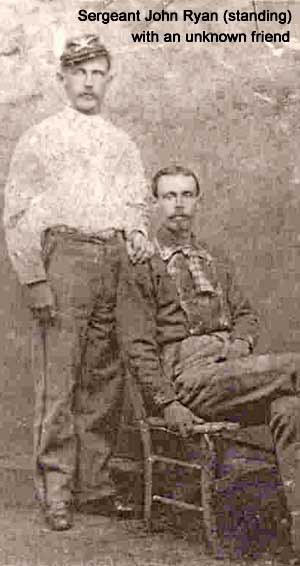
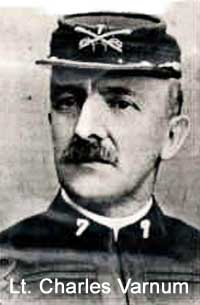 Reno's battalion started down the valley, first on a trot, and then at a gallop, marching in columns of twos.
Reno's battalion started down the valley, first on a trot, and then at a gallop, marching in columns of twos. 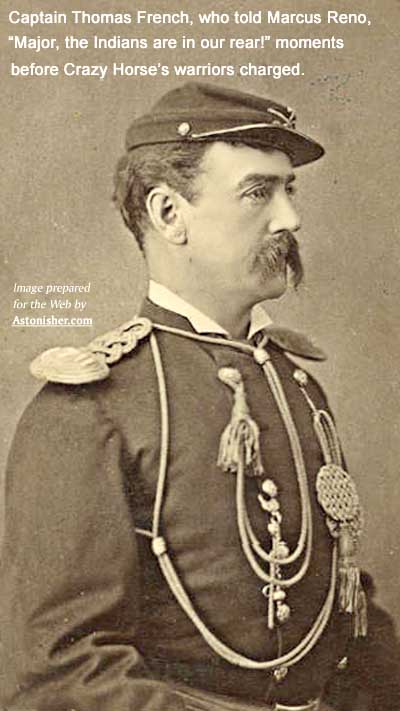
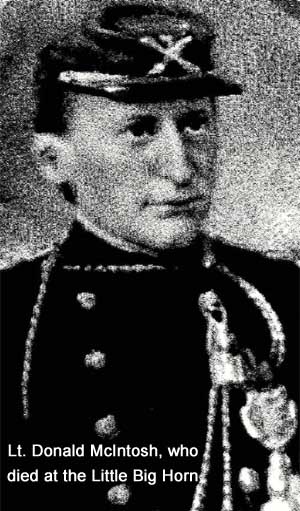
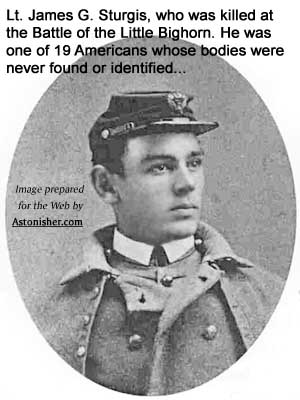
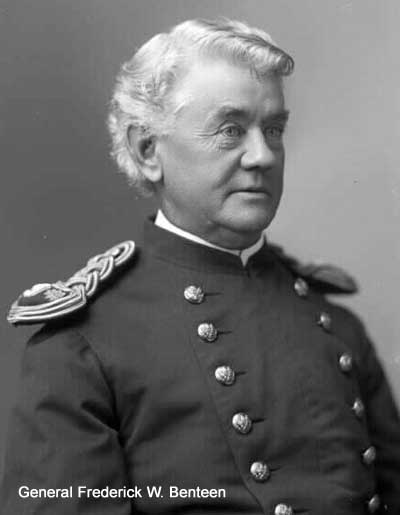 Benteen Saves Reno
Benteen Saves Reno







